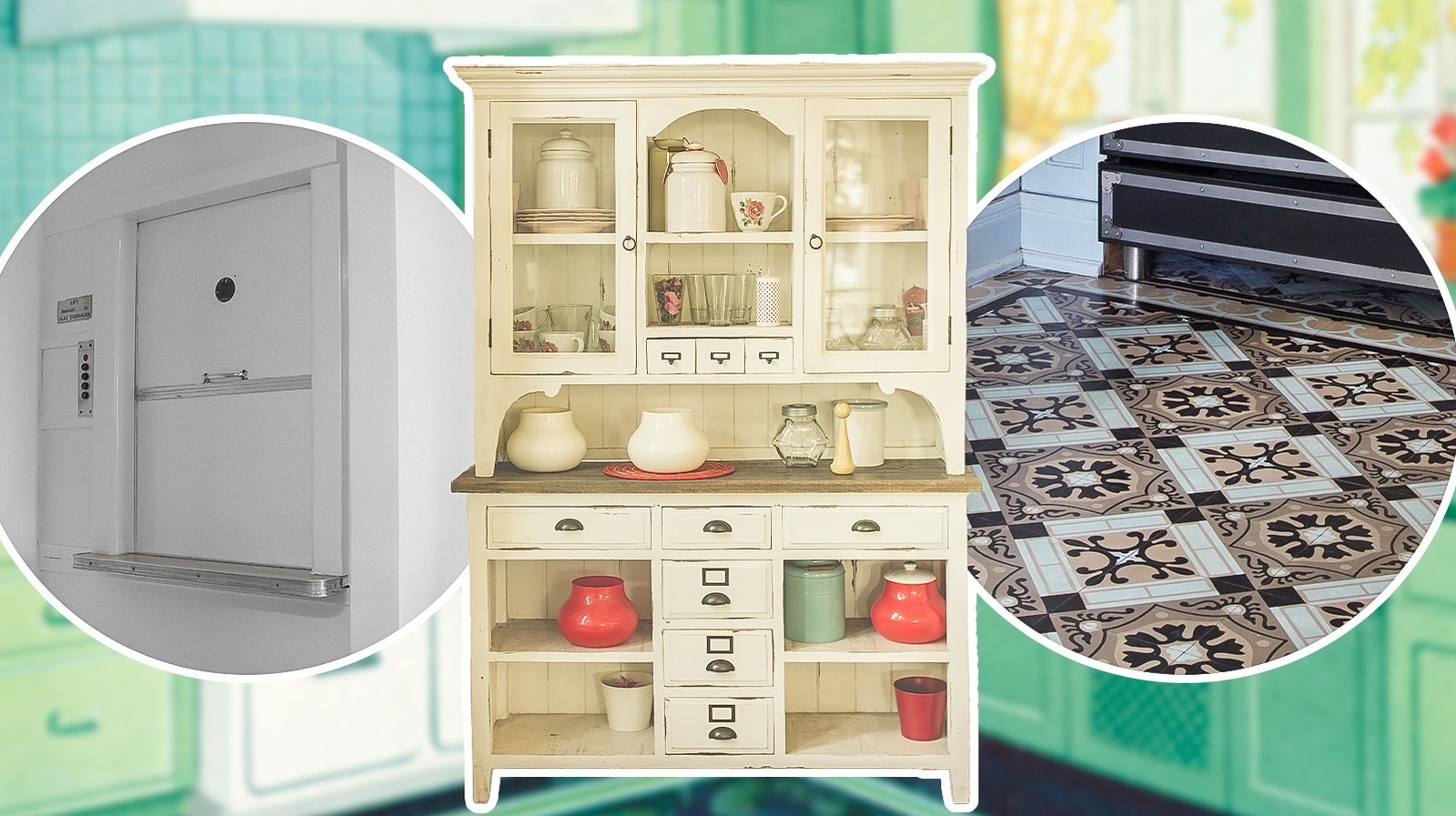Modern kitchens wow us with their sleek appliances and digital conveniences, but they’re missing the quirky, clever features that once defined vintage kitchens. Before double-door fridges and grills to-go became status symbols, cooks relied on a whole different set of ingenious features to solve everyday problems — like keeping bread fresh long before freezing was the norm. One contraption, introduced to America by a president, would even serve a covert role in national security. Another was considered so luxurious, it earned a place on the Titanic — a nod to its place at the pinnacle of home innovation.
These elements weren’t just practical; they shaped the way families cooked, entertained, and lived. For decades, they quietly served American households before slowly fading from memory. Today, many are sealed behind walls, hidden in floor plans, or simply forgotten altogether. In this piece, we revisit vintage kitchen features that, while rarely seen today, once stood at the forefront of American culinary life, offering a fascinating glimpse into how American kitchens, and the people who cooked in them, adapted, improvised, and thrived.
The Hoosier cabinet
Before kitchen islands or Pinterest-worthy pantries, there was the Hoosier cabinet, a freestanding multitasker that ruled American kitchens in the early 1900s. More than just a cupboard, it packed a flour sifter, sugar bin, spice carousel, pull-out enamel counter, and even metal-lined bread drawers all in one tidy space designed for maximum utility and organization.
Some doors even came printed with recipe charts, shopping lists, or meal-planning guides, while others had built-in hooks for utensils, baking tools, or towels. It was kitchen efficiency before “kitchen efficiency” was even a buzzword — a compact workstation designed to help homemakers move seamlessly through every step of meal prep. By 1920, the Hoosier Manufacturing Company had sold over two million cabinets to U.S. homeowners, and for good reason — they combined form, function, and innovation in a way no other furniture piece had.
If you’ve inherited one or spotted it in an antique store, look for clues like flour sifter patents, enameled pull-out work surfaces, or manufacturer labels from iconic makers like Sellers, McDougall, or Coppes Napanee to help date it. Earlier models were crafted from oak with ornate trim, while later versions in the 1920s featured lighter woods, enameled accents, and cleaner lines. Once the centerpiece of the kitchen, the Hoosier quietly faded with the rise of built-in cabinetry, but it remains a nostalgic piece of vintage kitchen genius.
Built-in bread boxes
Before plastic bags and pantry shelves, kitchens relied on a clever solution for keeping bread fresh: the built-in bread box. These weren’t the cute metal bins sitting on countertops that came later; they were integrated into the cabinetry, often with a sliding wood or metal door that kept your loaf tucked away and out of sight. More than just a space-saver, these boxes were all about function. Designed with just the right amount of airflow, they kept bread from going moldy too fast or drying into croutons overnight and attracting pests. Some even featured metal or enamel interiors, making cleanup easy, while containing crumbs. The rise of the “fitted kitchen” in the 20th century fueled their popularity. Built-in models, often with roll-top or sliding doors matching the rest of the kitchen, became standard. By the 1950s and 1960s, these built-in bread boxes were a common sight in American homes, marketed as hygienic, space-saving, and perfect for the era’s sleek, efficient design.
At the same time, freestanding bread boxes were also widely used, especially in homes without the latest cabinetry upgrades. While built-ins were seen as a premium feature in new or remodeled kitchens, freestanding versions remained popular for their affordability and portability. In the 1970s, as mass-produced, plastic-wrapped bread became commonplace and kitchen design shifted toward open shelving, the built-in versions quietly disappeared. They are, however, making a comeback as more people switch to fresh homemade bread.
Wall-mounted can openers
According to Reddit users, you’d be surprised how many old kitchens had a metal crank bolted to the wall, usually next to kitchen windows, above the sink, or under kitchen cabinets. If you’ve ever spotted one and wondered what it was, it’s a wall-mounted can opener, and for decades, it was just … there. No batteries to worry about, no drawer clutter, no rummaging through utensils mid-recipe. Just a sturdy, always-there tool that got the job done. As some users fondly noted, these openers were incredibly handy. But they came with a warning too: the cutting wheel, if neglected, could collect gunk over time.
These rugged tools were first marketed in 1927 by Central States Manufacturing Co. of St. Louis, Missouri. Wall-mounted can openers, especially the iconic Swing-A-Way models introduced in the 1930s, were the definition of reliable. You’d hook the can under the cutting wheel, clamp it securely by squeezing the handles or tightening the knob, then turn the crank handle so the serrated gear guides the can as the blade smoothly slices through the lid’s edge, continuing around until the top was fully cut. There were no cords to plug in, no batteries to charge, and no detachable parts to misplace. Best of all, it was always right where you left it — fixed to the wall, never buried in a messy drawer. As electric can openers became more popular, especially after their 1957 patent, wall-mounted versions slowly faded away.
Built-in flour sifters
Back when baking was a daily ritual and not just a weekend hobby, kitchens had a clever built-in tool tucked inside cabinets, especially in the iconic Hoosier cabinet. Enter: the flour sifter. This wasn’t the handheld mesh strainer you shake over a bowl. It was a full setup, a metal bin on top for bulk flour storage and a hand-crank sifter at the bottom that let you dispense soft, clump-free flour directly into your mixing bowl below.
Here’s how it worked: You’d pour several pounds of flour into the top bin. When it came time to bake, you simply turned the crank on the side or bottom of the cabinet. Inside, a fine mesh screen and rotating blades would sift the flour as it dropped, aerating it and filtering out clumps (and sometimes, the occasional bug, a real concern in the early 1900s).
They were efficient, tidy, and incredibly satisfying to use — common in homes as early as the 1930s and a staple by the 1950s. They held flour for biscuits, pies, and other baked goods, and came with a flat, enamel-coated slide-out surface just below, perfect for kneading or rolling dough. Eventually, boxed cake mixes, pre-sifted flour, and less daily baking made this once-essential feature obsolete. But if you ever spot a crank handle in an old cabinet, now you know. That’s a baking tool from a time when fresh pie crust was practically a daily duty.
Dumbwaiters
This “silent servant” earned its name literally — a speechless helper once found in elegant homes and grand estates of the 18th and 19th centuries. These small, hidden lifts, or in their earliest form, tiered serving stands and spring-loaded rotating shelves, once played a starring role in how food and beverages traveled discreetly through multi-story establishments. Their origins trace back to ancient Greece and Rome, often crafted from walnut, oak, mahogany, or even exotic woods. Thomas Jefferson encountered them in France and brought the idea back to the U.S.
As president, he installed a rotating dumbwaiter in the White House dining room. Not just to avoid the interruption of servants, but as a matter of national security. With espionage still a concern after the Revolutionary War, he could host diplomatic dinners without fear of eavesdropping staff. At Monticello, Jefferson, who also popularized ice cream, used five wall-mounted dumbwaiters to send meals out from the kitchen and whisk empty dishes back. In 1887, George W. Cannon patented the first mechanical dumbwaiter — a rope-and-pulley lift with guide rails and counterweights that became a staple in homes, tenements, and restaurants, hauling everything from roast dinners to coal.
By the 1920s, dumbwaiters went electric. They could stop on multiple floors, carry up to 500 pounds, and were used in restaurants, hospitals, and even libraries to shuttle books. But then they quietly disappeared as open-concept kitchens became popular. Today, many dumbwaiters are sold as relics and their shafts remain sealed.
Built-in desk nooks in the kitchen
Long before digital calendars and meal-planning apps, families had a different kind of HQ: the built-in kitchen desk nook. Usually tucked into a corner, beneath a window, or beside the fridge, these cozy spots were where recipes got clipped, grocery lists were scribbled, and permission slips were signed with a cup of coffee nearby.
Online, many recall them as multipurpose zones used for paying bills, doing homework, taking phone messages, or even housing the family’s first computer. Popular in mid-century to late 20th-century homes — especially from the 1950s through the 1990s — these nooks weren’t just decorative; they were designed with a purpose. A drawer for pens, a corkboard for notes, maybe a cubby for cookbooks or unpaid bills. Other families turned them into informal command centers where calendars, mail, reminders, and day-to-day tasks were managed. Some even had phone jacks installed, making them the ultimate multitasking station: part office, part family bulletin board. More commenters remember the space doubling as a quiet homework corner or a spot to balance the checkbook while dinner simmered nearby. In time, some desks became catchalls for clutter, places for pet bowls, or later repurposed into wine fridges or coffee bars.
As open-concept kitchens took over and laptops replaced notepads, these thoughtful corners lost favor. But every now and then, you’ll spot these retro kitchen design features in vintage homes; a tiny workspace carved into domestic life, equal parts practical and sentimental.
Linoleum flooring in the kitchen
Linoleum flooring was invented by Frederick Walton in England in 1855. By 1869, it had arrived in the United States, with Walton opening a New York plant in 1872. It quickly became a major innovation for kitchens and bathrooms across Wisconsin and beyond between the 1890s and the 1940s because its composition was a marvel of its time: large sheets made from linseed oil, resins, and canvas. It was available in two main styles: an inlaid version, where solid colors of linoleum were pieced together into patterns, and a printed version, where patterns were printed onto the surface. The inlaid type was durable and easy to repair, while the printed variety was more vulnerable to wear over time.
The appeal of linoleum was not just its practical benefits — waterproof, noiseless, and warm — but also its aesthetic versatility. By the 1940s, linoleum was an international sensation across the globe. It was durable, easy to make, supposedly antibacterial, and could be mixed and remixed into hundreds of beautiful colors and patterns, from faux marble, zig-zagging bricks, and wood to bold checks and florals. It was even installed aboard the Titanic around the pool and on the staircase.
Despite its early popularity, linoleum eventually fell out of favor. The very traits that made it beloved became liabilities as tastes changed. It was gradually replaced by plastic-based flooring in the 1950s and 1960s, and by the 1970s, manufacturers shifted to vinyl instead.
Fluorescent box lights
Walk into a suburban kitchen from the 1970s, ’80s, or early ’90s, and chances are the ceiling was glowing with a large, plastic rectangle: the iconic fluorescent box light. Tucked into drop ceilings or soffit frames, these fixtures used long fluorescent tubes that provided bright, even illumination across the kitchen. Unlike traditional incandescent bulbs that consumed more energy, emitted more heat, and often created shadows, fluorescent box lights offered broader, more even illumination with better energy efficiency, eliminating the need for additional lamps.
Fluorescent lighting itself dates back to the 1890s and became commercially viable by 1934, with later innovations like T12, T8, and T5 lamps improving efficiency and cementing their place in mid-century homes. While the technology existed earlier, it wasn’t until the post-WWII housing boom that it found its way into residential kitchens. By the 1970s, fluorescent box lights were marketed as a futuristic upgrade, a smarter, sleeker alternative to dim overhead bulbs. They promised greater energy efficiency, less heat, and far better coverage.
Over time, they evolved from bulky industrial tubes into “home-friendly” designs with faux wood trim and decorative plastic panels. However, these design choices often failed to age well. As the years went on, the harsh, unnatural light quality, occasional flickering, and low design appeal wore thin. By the early 2000s, advances in lighting technology, particularly the rise of dimmable recessed lighting and LED fixtures, led to a decline in the popularity of fluorescent box lights.
The California cooler
Before stainless steel refrigerators and walk-in chillers became household staples, many West Coast kitchens featured a clever, hidden gem integrated right into the cabinetry: the California cooler. Far from a modern appliance, this was an early, passive refrigeration system — a well-ventilated cupboard that relied on natural air circulation to keep food cool, long before electric refrigerators became widespread. These coolers originated in early 20th-century California homes, typically built on exterior-facing walls to take advantage of cooler outdoor air. Vents placed at the top and bottom created a natural convection current, pulling fresh air through slatted wooden shelves and allowing it to circulate produce, bread, dairy, and leftovers.
Think of it as California’s take on the larder, the traditional British pantry built of stone or brick. However, unlike the large, often walk-in stone or brick larders designed to maintain cool, stable temperatures through mass and shade, this was a compact, cabinet-integrated solution ideal for the Golden State’s milder, temperate climate. It offered a sustainable, low-tech way to extend shelf life, decades before eco-friendly kitchen design became a trend.
Once electric refrigerators became more affordable and widely available in the mid-20th century, California coolers gradually disappeared. But if you come across a slatted cabinet with wall vents in an older California home, you may be looking at a surviving or forgotten California cooler.
Milk doors
At first glance, it might seem like a random hatch in the wall, but in vintage kitchens, the milk door was a show of thoughtful design and old-school practicality. Built directly into an exterior-facing wall, this double-sided compartment quietly connected the kitchen to the outside world, allowing milkmen to deliver fresh bottles of milk or butter without entering the home or disturbing its occupants. The milkman would unlatch the outside door, place the day’s delivery inside the small cubby (sometimes insulated), and close it up. Later, the homeowner could retrieve the items by opening the interior door from the kitchen, eliminating interruptions to daily routines. No small talk. No need to change out of a robe.
More than a clever convenience, the milk door reflected the social norms of the time, especially in Puritan-influenced communities, where it was frowned upon for a housewife to engage with a delivery man while home alone. So, homes were built to keep things modest and separate.
While these doors peaked in the 1930s and ’40s, they faded with the rise of refrigerators and supermarket culture. Despite their diminished functional role, many historic homes still retain milk doors, now reimagined as creative pass-throughs for meal kits, secure package drop-offs, or conversation pieces that celebrate architectural heritage. A Reddit thread shared imaginative ways to repurpose them, from turning them into emergency snack stashes and secret key holders to decorating them with whimsical miniatures or nostalgic milk bottle displays.











